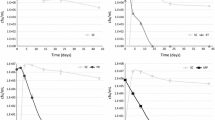Abstract
The combined effects of lactic acid and acetic acid on ethanol production by S. cerevisiae in corn mash, as influenced by temperature, were examined. Duplicate full factorial experiments (three lactic acid concentrations × three acetic acid concentrations) were performed to evaluate the interaction between lactic and acetic acids on the ethanol production of yeast at each of the three temperatures, 30, 34, and 37°C. Corn mash at 30% dry solids adjusted to pH 4 after lactic and acetic acid addition was used as the substrate. Ethanol production rates and final ethanol concentrations decreased (P<0.001) progressively as the concentration of combined lactic and acetic acids in the corn mash increased and the temperature was raised from 30 to 37°C. At 30°C, essentially no ethanol was produced after 96 h when 0.5% w/v acetic acid was present in the mash (with 0.5, 2, and 4% w/v lactic acid). At 34 and 37°C, the final concentrations of ethanol produced by the yeast were noticeably reduced by the presence of 0.3% w/v acetic acid and ≥2% w/v lactic acid. It can be concluded that, as in previous studies with defined media, lactic acid and acetic acid act synergistically to reduce ethanol production by yeast in corn mash. In addition, the inhibitory effects of combined lactic and acetic acid in corn mash were more apparent at elevated temperatures.


Similar content being viewed by others
References
Abbott DA, Ingledew WM (2004) Buffering capacity of whole corn mash alters concentrations of organic acids required to inhibit growth of Saccharomyces cerevisiae and ethanol production. Biotechnol Lett 26:1313–1316
Carmelo V, Santos R, Viegas CA, Sa-Correia I (1998) Modification of Saccharomyces cerevisiae thermotolerance following rapid exposure to acid stress. Int J Food Microbiol 42:225–230
Cheng L, Piper PW (1994) Weak acid preservatives block the heat shock response and heat-shock-element-directed lacZ expression of low pH Saccharomyces cerevisiae cultures, an inhibitory action partially relieved by respiratory deficiency. Microbiology 140:1085–1096
Garay-Arroyo A, Covarrubias AA, Clark I, Nino I, Gossett G, Martinez A (2004) Response to different environmental stress conditions of industrial and laboratory Saccharomyces cerevisiae strains. Appl Microbiol Biotechnol 63:734–741
Graves T, Narendranath N, Dawson K, Power R (2006) Effect of pH and lactic or acetic acid on ethanol productivity by Saccharomyces cerevisiae in corn mash. J Ind Microbiol Biotechnol. DOI https://doi.org/10.1007/s10295-006-0091-6
Halm M, Hornbaek T, Arneborg N, Sefa-Dedeh S, Jespersen L (2004) Lactic acid tolerance determined by measurement of intracellular pH of single cells of Candida krusei and Saccharomyces cerevisiae isolated from fermented maize dough. Int J Food Microbiol 94:97–103
Lloyd D, Morell S, Carlsen HN, Degn H, James PE, Towlands CC (1993) Effects of growth with ethanol on fermentation and membrane fluidity of Saccharomyces cerevisiae. Yeast 9:825–833
Makanjuola DB, Tymon A, Springham DG (1992) Some effects of lactic acid bacteria on laboratory scale yeast fermentations. Enzyme Microb Technol 14:351–357
Narendranath NV, Hynes SH, Thomas KC, Ingledew WM (1997) Effects of lactobacilli on yeast-catalyzed ethanol fermentations. Appl Environ Microbiol 63:4158–4163
Narendranath NV, Thomas KC, Ingledew WM (2001a) Effects of acetic acid and lactic acid on the growth of Saccharomyces cerevisiae in a minimal medium. J Ind Microbiol Biotech 26:171–177
Narendranath NV, Thomas KC, Ingledew WM (2001b) Acetic acid and lactic acid inhibition of growth of Saccharomyces cerevisiae by different mechanisms. J Am Soc Brew Chem 59:187–194
Ohta K, Wijeyaratne SC, Hayashida S (1988) Temperature-sensitive mutants of a thermotolerant yeast, Hansenula polymorpha. J Ferment Technol 66:455–459
Palmqvist E, Grage H, Meinander NQ, Hahn-Hagerdal B (1999) Main and interaction effects of acetic acid, furfural, and p-hydroxybenzoic acid on growth and ethanol productivity of yeasts. Biotechnol Bioeng 63:46–55
Pampulha ME, Loureiro-Dias MC (2000) Energetics of the effect of acetic acid on growth of Saccharomyces cerevisiae FEMS Microbiol Lett 184:69–72
Rose AH (1993) Composition of the envelope layers of Saccharomyces cerevisiae in relation to flocculation and ethanol tolerance. J Appl Bacteriol 74:109–112
Savard T, Beaulieu C, Gardner NJ, Champagne CP (2002) Characterization of spoilage yeasts isolated from fermented vegetables and inhibition by lactic, acetic and propionic acids. Food Microbiol 19:363–373
SAS Institute (1988) SAS/STAT® User’s Guide. Release 6.03 Edition. SAS Institute, Cary, NC, pp 91–100, 139–200
Skinner KA, Leathers TD (2004) Bacterial contaminants of fuel ethanol production. J Ind Microbiol Biotech 31:401–408
Stewart GG, D’Amore T, Panchal CJ, Russell I (1988) Factors that influence the ethanol tolerance of brewer’s yeast strains during high gravity wort fermentations. MBAA Technical Quarterly 25:47–53
Taherzadeh MJ, Niklasson C, Liden G (1997) Acetic acid—friend or foe in anaerobic batch conversion of glucose to ethanol by Saccharomyces cerevisiae? Chem Eng Sci 52:2653–2659
Thomas KC, Hynes SH, Ingledew WM (1994) Effects of particulate materials and osmoprotectants on very-high-gravity ethanolic fermentation by Saccharomyces cerevisiae. Appl Environ Microbiol 60:1519–1524
Thomas KC, Hynes SH, Ingledew WM (2001) Effect of lactobacilli on yeast growth, viability and batch and semi-continuous alcoholic fermentation of corn mash. Appl Environ Microbiol 90:819–828
Thomas KC, Hynes SH, Ingledew WM (2002) Influence of medium buffering capacity on inhibition of Saccharomyces cerevisiae growth by acetic and lactic acids. Appl Environ Microbiol 68:1616–1623
Wang S, Ingledew WM, Thomas KC, Sosulski K, Sosulski FW (1999) Optimization of fermentation temperature and mash specific gravity for fuel alcohol production. Cereal Chem 76:82–86
Author information
Authors and Affiliations
Corresponding author
Rights and permissions
About this article
Cite this article
Graves, T., Narendranath, N.V., Dawson, K. et al. Interaction effects of lactic acid and acetic acid at different temperatures on ethanol production by Saccharomyces cerevisiae in corn mash. Appl Microbiol Biotechnol 73, 1190–1196 (2007). https://doi.org/10.1007/s00253-006-0573-5
Received:
Revised:
Accepted:
Published:
Issue Date:
DOI: https://doi.org/10.1007/s00253-006-0573-5




